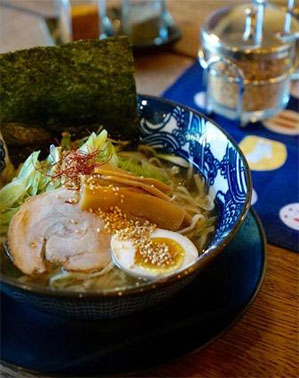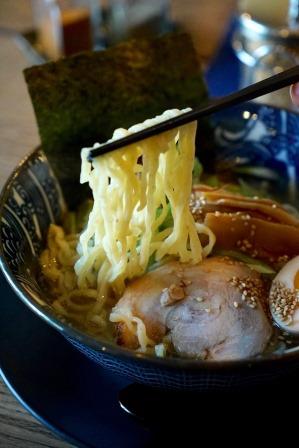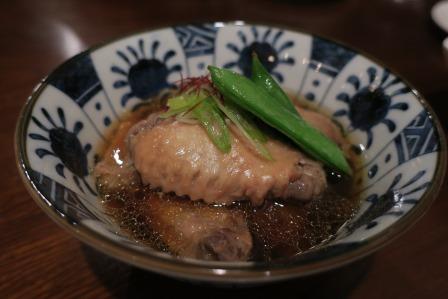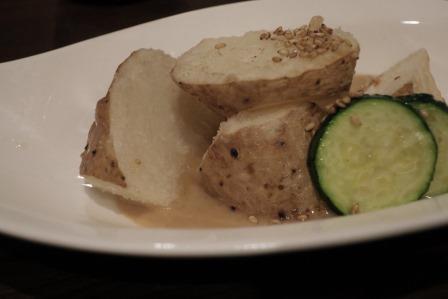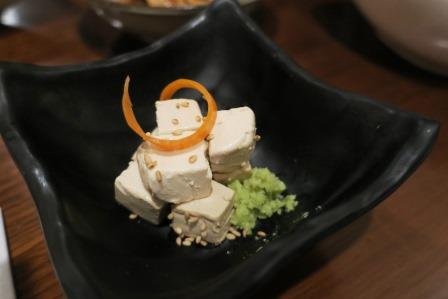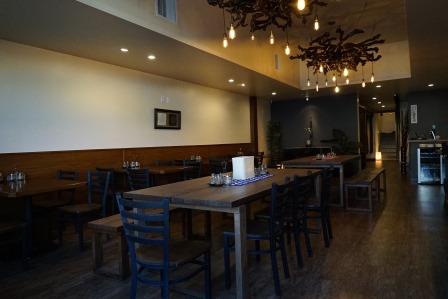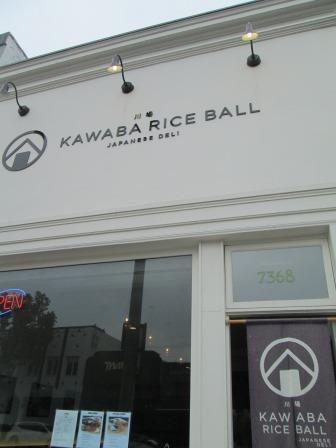Fresh air of Japan Town! Uncompromising “Dashi Ramen”
By Elli Sekine
In November of last year, a new style of “wafu” (Japanese) ramen appeared in San Francisco’s Japan Town which is known for the area as one of the hottest battle grounds for the ramen business. Lately, in Japan Town, due to the continuing generation change, the appearance of the town is slowly changing to “Asian-style” rather than Japanese. In such an environment, a long-hoped wish, a strong ambition “to spread traditional Japanese dashi taste to the world”, of the owner, Ikuto Kurihara, came alive. Mr. Kurihara is the fourth CEO of “Sasala” Group, a long-established Japanese restaurant chain, and runs 4 restaurants in Hasuda city, Saitama prefecture. He chose San Francisco as the first overseas branch, the fifth restaurant chain, “Hinodeya”. Their wafu-dashi ramen which may replace the current tonkotsu–base ramen boom has been heating up since the opening. This fourth CEO is like a samurai who challenges the U.S restaurant market with the traditional Japanese taste on the front banner he holds.
Born into a long-established Japanese restaurant environment, Mr. Kurihara went into the cooking world when he was a teenager. He inherited the family business sometime after the year 2000. Since then, he has expanded the business to 4 different themed restaurants, soba, Japanese food, etc. The fourth one, “The Fourth Generation Hinodeya” which served the dashi ramen in the hopes of taking it to the United States, won “The Best Ramen 2014”. The very settled and well-thought concept, rather than an idea of the moment, is bearing fruit in San Francisco.
The signature menu, “Hinodeya Ramen” is the ultimate Japanese taste which Mr. Kurihara created by working so hard on it. I asked him why he chose ramen as the means of spreading the traditional dashi taste, and he answered, “The most familiar Japanese food to Americans currently is ramen. Most of the other ramen shops serve mainly tonkotsu-base soup, but I wanted to serve the Japanese taste I have been acquiring in the form of ramen”. As for the reason for choosing San Francisco as the first overseas location, he said, “I recognize that the melting pot that sends information of the latest trend in foods is here in San Francisco. I believe that cuisine approved in this town shall be approved all over the United States, and eventually by the whole world.” His strategy already depicts 10 years from now.
What does the “Dashi Ramen” taste like? In short, it is delicate and tender with a fragrance of fresh bonito and kombu flavors. This is the ramen of concentrated umami. Unlike the current main-stream ramen flavors that are dominant in the ramen boom such as rich tonkotsu, spice-added, or stimulating flavors with karaage or tonkatsu toppings, it is light with a hint of sweetness. The men (noodles) to match the dashi soup is also different. It is medium-thick like between ramen and udon, and soft, and moist, with a lipid and chewy texture. It is very delicate. The toppings are thinly sliced chashu pork, light-taste boiled egg, etc., which go well with the soup, and also mix easily with the men. Crispy julienne Tokyo negi (leek) accentuates the soup. The spacious counter is decorated with sake bottles, and used as a space for waiting customers.
Chef Shibata from “Sasala” Japanese restaurant in Japan was displaying his skills as the opening chef here. He told me his impression about the ramen boom in the United States; “Preparation starts in the early morning. There is no difference between a ramen restaurant and a Japanese food restaurant. I would like to express true Japanese taste by riding on the same lucky wave of this ramen boom”. In their menu, you see the kind of a-la-carte dishes you find in a long-established Japanese restaurant besides ramen. ”Crispy Fried Yam” ($8) in the Okazu menu, for instance, is slightly crispy in the center, but the surface is fluffy, and the thin skin is still attached. The Chinese yam is fried for a very short time to retain the texture, and served with a fragrant house sesame sauce. A popular dish from the side dish menu is the “Cheese Royal” ($5), which was named after Kiko, Princess Akishino, who loved the marinated cheese dish in the menu when they had a chance to serve the Royal family. There are more original dishes, which the long-established restaurant boasts of, such as tender tebasaki chicken cooked in dashi ($8), nori konnyaku (seaweed yam cake), cooked young bamboo shoot, etc. You can also order omakase-style meals if reserved in advance.
It is almost a miracle that the proud family dashi recipe which has been kept a secret for more than 130 years came to the United States. The beautiful exterior which stands out in the decrepit mall, and the sophisticated interior are designed by specialists. Things of Japanese atmosphere scattered in the interior space, the table ware, and the service produce Japanese style hospitality. This is a restaurant where you can truly feel the spirit of the fourth CEO who hopes to spread “Japanese cuisine”, a chosen intangible cultural heritage, to the world.
日本町に新風!こだわりの「出汁ラーメン」
ラーメンの激戦区、SF日本町に去年11月、「和風」ラーメンの新星が登場した。近年、日本町では世代交代が相次ぎ、町の様相も“アジア系” に変わりつつある。そんな中、「日本伝統の出汁味を世界に広げたい」という高い志を持つ経営者、栗原生人氏の長年の構想が始動している。栗原氏は、老舗和食店4代目、「彩々楽」(ササラ)グループ代表取締役で、埼玉県蓮田市で4件のレストランを経営している。今回、5件目のオープンが海外1号店が和風ラーメン「Hinodeya」だ。この新店舗は、米国に広がる豚骨中心の中心のブームを一世風靡するような和風出汁味。その新しい味を体験しようと、去年11月のソフトオープンからヒートアップしている。4代目は日本の伝統の味を提げ米国外食市場に挑むサムライのような存在だ。
和食老舗店に生まれた栗原氏は、 10代の頃から料理界に入り、稼業を継いだのは2000年に入ってから。現在まで蕎麦屋から和食店など各テーマを持つ4店舗に拡大している。4店舗目の「四代目ひのでや」は、米国への進出を見込んで出汁ラーメンを提供したところ、「埼玉ベストラーメン2014」を受賞した。単なる思い付きではない、腰を据えての構想は今サンフランシスコで実を結んでいる。
看板メニュー、「Hinodeya Ramen」は、栗原氏が切磋琢磨して創り上げた和風の極みだ。ラーメンという手段を選んだ理由について、「現在アメリカ人に一番親しまれている日本食がラーメンだった。でも見渡せばほとんどの店は豚骨スープで、私が培った和風味をラーメンという形で賞味して欲しいという思いです」と栗原氏。そして海外1店舗目にサンフランシスコを選んだ理由について、「食トレンドの最新情報発信基地がここにあると認識しました。ここで認められた料理は全米、やがて世界に通用するという展望です」と答えた。その戦略はすでに10年先の構想が描かれている。
「出汁ラーメン」とはどんな味なのか。一言で言うなら、新鮮な鰹と昆布の風味が香る繊細で優しい味。旨味が詰まったラーメンだ。ラーメンブームの一線を博す豚骨コッテリ系、または辛味を加えたり、唐揚げやトンカツをのせた刺激的なラーメンと異なり、あっさり系で微妙な甘みもある。また麺もスープにマッチするべくラーメンとうどんの中間のような麺で冠水を入れず糖質を抑えた、コシはあるが柔らかめの中太麺。デリケートな食感だ。トッピングは薄切りのチャーシュー、薄味の煮卵といった出汁味と絡みやすく麺との相性も良い。シャキシャキの東京ネギがアクセントになっている。広いカウンターにはお酒も並べられ、バー兼客の待ちスペースになっている。
オープニングの料理長には、日本の「彩々楽」(ささら)和食店から柴田シェフが腕をふるっていた。アメリカのラーメンブームの印象を同氏は、「このブームにあやかり、本当の和風の味を表現したいと思っています」と答えてくれた。仕込みは早朝から始まる。ラーメン店でありながら和食店と変わりはない。メニューはラーメン以外にも老舗和食店ならではの一品料理が並ぶ。例えばOkazu から「Crispy Fried Yam」($8)は、微妙な食感を中心に残しながらも周りはホクホクして薄い皮もそのまま、柔らかく食感を残す長芋をサッと揚げたものに香ばしい自家製セサミソース付きやおつまみから人気なのは「Cheese Royal」($5)。メニュー名の由来は、食事を天皇家族にお出しした際、紀子様が漬けチーズを非常にお気に召した事から付けられたとか。その他、柔らかく出汁で煮込んだ手羽先($8)や海苔こんにゃく、若竹煮込みなども老舗が誇るオリジナルだ。予約によってはオマカセメニューも用意している。
130年以上守り続けてきた家族経営店の秘伝の和風出汁が米国に進出したのは奇跡に近い。老朽化したモールに一際目立つ美しい外観、洗練されたインテリアは専門デザイナーによるもの。店内には和のテイストが散りばめられ、食器、サービスに至るまで日本の「おもてなし」を再現している。無形文化遺産に選ばれた「和食」文化を絶やさず世界に広げていきたいとする四代目のスピリットを感じ取れる店だ。
Hinodeya
1737 Buchanan St
San Francisco, CA 94115
(415) 757-0552
http://www.sasala-group.com/hinodeya/
Wed-Non 5:00 pm - 10:00 pm
Sat,Sun 11:30 am - 2:30 pm
Closed on Tuesday
In November of last year, a new style of “wafu” (Japanese) ramen appeared in San Francisco’s Japan Town which is known for the area as one of the hottest battle grounds for the ramen business. Lately, in Japan Town, due to the continuing generation change, the appearance of the town is slowly changing to “Asian-style” rather than Japanese. In such an environment, a long-hoped wish, a strong ambition “to spread traditional Japanese dashi taste to the world”, of the owner, Ikuto Kurihara, came alive. Mr. Kurihara is the fourth CEO of “Sasala” Group, a long-established Japanese restaurant chain, and runs 4 restaurants in Hasuda city, Saitama prefecture. He chose San Francisco as the first overseas branch, the fifth restaurant chain, “Hinodeya”. Their wafu-dashi ramen which may replace the current tonkotsu–base ramen boom has been heating up since the opening. This fourth CEO is like a samurai who challenges the U.S restaurant market with the traditional Japanese taste on the front banner he holds.
Born into a long-established Japanese restaurant environment, Mr. Kurihara went into the cooking world when he was a teenager. He inherited the family business sometime after the year 2000. Since then, he has expanded the business to 4 different themed restaurants, soba, Japanese food, etc. The fourth one, “The Fourth Generation Hinodeya” which served the dashi ramen in the hopes of taking it to the United States, won “The Best Ramen 2014”. The very settled and well-thought concept, rather than an idea of the moment, is bearing fruit in San Francisco.
The signature menu, “Hinodeya Ramen” is the ultimate Japanese taste which Mr. Kurihara created by working so hard on it. I asked him why he chose ramen as the means of spreading the traditional dashi taste, and he answered, “The most familiar Japanese food to Americans currently is ramen. Most of the other ramen shops serve mainly tonkotsu-base soup, but I wanted to serve the Japanese taste I have been acquiring in the form of ramen”. As for the reason for choosing San Francisco as the first overseas location, he said, “I recognize that the melting pot that sends information of the latest trend in foods is here in San Francisco. I believe that cuisine approved in this town shall be approved all over the United States, and eventually by the whole world.” His strategy already depicts 10 years from now.
What does the “Dashi Ramen” taste like? In short, it is delicate and tender with a fragrance of fresh bonito and kombu flavors. This is the ramen of concentrated umami. Unlike the current main-stream ramen flavors that are dominant in the ramen boom such as rich tonkotsu, spice-added, or stimulating flavors with karaage or tonkatsu toppings, it is light with a hint of sweetness. The men (noodles) to match the dashi soup is also different. It is medium-thick like between ramen and udon, and soft, and moist, with a lipid and chewy texture. It is very delicate. The toppings are thinly sliced chashu pork, light-taste boiled egg, etc., which go well with the soup, and also mix easily with the men. Crispy julienne Tokyo negi (leek) accentuates the soup. The spacious counter is decorated with sake bottles, and used as a space for waiting customers.
Chef Shibata from “Sasala” Japanese restaurant in Japan was displaying his skills as the opening chef here. He told me his impression about the ramen boom in the United States; “Preparation starts in the early morning. There is no difference between a ramen restaurant and a Japanese food restaurant. I would like to express true Japanese taste by riding on the same lucky wave of this ramen boom”. In their menu, you see the kind of a-la-carte dishes you find in a long-established Japanese restaurant besides ramen. ”Crispy Fried Yam” ($8) in the Okazu menu, for instance, is slightly crispy in the center, but the surface is fluffy, and the thin skin is still attached. The Chinese yam is fried for a very short time to retain the texture, and served with a fragrant house sesame sauce. A popular dish from the side dish menu is the “Cheese Royal” ($5), which was named after Kiko, Princess Akishino, who loved the marinated cheese dish in the menu when they had a chance to serve the Royal family. There are more original dishes, which the long-established restaurant boasts of, such as tender tebasaki chicken cooked in dashi ($8), nori konnyaku (seaweed yam cake), cooked young bamboo shoot, etc. You can also order omakase-style meals if reserved in advance.
It is almost a miracle that the proud family dashi recipe which has been kept a secret for more than 130 years came to the United States. The beautiful exterior which stands out in the decrepit mall, and the sophisticated interior are designed by specialists. Things of Japanese atmosphere scattered in the interior space, the table ware, and the service produce Japanese style hospitality. This is a restaurant where you can truly feel the spirit of the fourth CEO who hopes to spread “Japanese cuisine”, a chosen intangible cultural heritage, to the world.
日本町に新風!こだわりの「出汁ラーメン」
ラーメンの激戦区、SF日本町に去年11月、「和風」ラーメンの新星が登場した。近年、日本町では世代交代が相次ぎ、町の様相も“アジア系” に変わりつつある。そんな中、「日本伝統の出汁味を世界に広げたい」という高い志を持つ経営者、栗原生人氏の長年の構想が始動している。栗原氏は、老舗和食店4代目、「彩々楽」(ササラ)グループ代表取締役で、埼玉県蓮田市で4件のレストランを経営している。今回、5件目のオープンが海外1号店が和風ラーメン「Hinodeya」だ。この新店舗は、米国に広がる豚骨中心の中心のブームを一世風靡するような和風出汁味。その新しい味を体験しようと、去年11月のソフトオープンからヒートアップしている。4代目は日本の伝統の味を提げ米国外食市場に挑むサムライのような存在だ。
和食老舗店に生まれた栗原氏は、 10代の頃から料理界に入り、稼業を継いだのは2000年に入ってから。現在まで蕎麦屋から和食店など各テーマを持つ4店舗に拡大している。4店舗目の「四代目ひのでや」は、米国への進出を見込んで出汁ラーメンを提供したところ、「埼玉ベストラーメン2014」を受賞した。単なる思い付きではない、腰を据えての構想は今サンフランシスコで実を結んでいる。
看板メニュー、「Hinodeya Ramen」は、栗原氏が切磋琢磨して創り上げた和風の極みだ。ラーメンという手段を選んだ理由について、「現在アメリカ人に一番親しまれている日本食がラーメンだった。でも見渡せばほとんどの店は豚骨スープで、私が培った和風味をラーメンという形で賞味して欲しいという思いです」と栗原氏。そして海外1店舗目にサンフランシスコを選んだ理由について、「食トレンドの最新情報発信基地がここにあると認識しました。ここで認められた料理は全米、やがて世界に通用するという展望です」と答えた。その戦略はすでに10年先の構想が描かれている。
「出汁ラーメン」とはどんな味なのか。一言で言うなら、新鮮な鰹と昆布の風味が香る繊細で優しい味。旨味が詰まったラーメンだ。ラーメンブームの一線を博す豚骨コッテリ系、または辛味を加えたり、唐揚げやトンカツをのせた刺激的なラーメンと異なり、あっさり系で微妙な甘みもある。また麺もスープにマッチするべくラーメンとうどんの中間のような麺で冠水を入れず糖質を抑えた、コシはあるが柔らかめの中太麺。デリケートな食感だ。トッピングは薄切りのチャーシュー、薄味の煮卵といった出汁味と絡みやすく麺との相性も良い。シャキシャキの東京ネギがアクセントになっている。広いカウンターにはお酒も並べられ、バー兼客の待ちスペースになっている。
オープニングの料理長には、日本の「彩々楽」(ささら)和食店から柴田シェフが腕をふるっていた。アメリカのラーメンブームの印象を同氏は、「このブームにあやかり、本当の和風の味を表現したいと思っています」と答えてくれた。仕込みは早朝から始まる。ラーメン店でありながら和食店と変わりはない。メニューはラーメン以外にも老舗和食店ならではの一品料理が並ぶ。例えばOkazu から「Crispy Fried Yam」($8)は、微妙な食感を中心に残しながらも周りはホクホクして薄い皮もそのまま、柔らかく食感を残す長芋をサッと揚げたものに香ばしい自家製セサミソース付きやおつまみから人気なのは「Cheese Royal」($5)。メニュー名の由来は、食事を天皇家族にお出しした際、紀子様が漬けチーズを非常にお気に召した事から付けられたとか。その他、柔らかく出汁で煮込んだ手羽先($8)や海苔こんにゃく、若竹煮込みなども老舗が誇るオリジナルだ。予約によってはオマカセメニューも用意している。
130年以上守り続けてきた家族経営店の秘伝の和風出汁が米国に進出したのは奇跡に近い。老朽化したモールに一際目立つ美しい外観、洗練されたインテリアは専門デザイナーによるもの。店内には和のテイストが散りばめられ、食器、サービスに至るまで日本の「おもてなし」を再現している。無形文化遺産に選ばれた「和食」文化を絶やさず世界に広げていきたいとする四代目のスピリットを感じ取れる店だ。
Hinodeya
1737 Buchanan St
San Francisco, CA 94115
(415) 757-0552
http://www.sasala-group.com/hinodeya/
Wed-Non 5:00 pm - 10:00 pm
Sat,Sun 11:30 am - 2:30 pm
Closed on Tuesday





